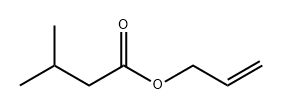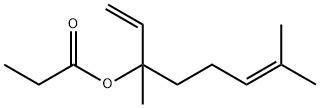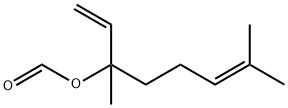LINALYL ISOVALERATE
Synonym(s):Linalyl 3-methylbutanoate
- CAS NO.:1118-27-0
- Empirical Formula: C15H26O2
- Molecular Weight: 238.37
- MDL number: MFCD00048304
- EINECS: 214-259-4
- SAFETY DATA SHEET (SDS)
- Update Date: 2024-12-18 14:07:02

What is LINALYL ISOVALERATE?
Description
Linalyl isovalerate has a stable, suave, fruity odor and a sweet, apple-like taste somewhat reminiscent of plum and peach. May be synthesized from dehydrolinalool and isovaleric acid followed by hydrogenation; also from linalool and isovaleric acid by azeotropic esterification.
Chemical properties
Linalyl isovalerate has a stable, suave, fruity odor and a sweet, apple-like taste somewhat reminiscent of plum and peach.
Occurrence
Reported found in nature (Salvia officinalis and Salvia spinosa).
The Uses of LINALYL ISOVALERATE
Linalyl isovalerate is found in heavy exotic floral fragrance, Chypres, and some Oriental types. It blends excellently with Clary Sage and Oakmoss, as well as Jasmin, Neroli and Petitgrain. It seems to be very stable and performs well in soap. In flavour compositions, it finds its way into imitation Apples, Apricots, Loganberry and other berries, Peaches, Plums, etc., in a concentration equivalent to 1 to 6 ppm in the functional consumer product.
Preparation
From dehydrolinalool and isovaleric acid followed by hydrogenation; also from linalool and isovaleric acid by azeotropic esterification.
Properties of LINALYL ISOVALERATE
| Boiling point: | 188 °C(lit.) |
| Density | 0.885 g/mL at 25 °C(lit.) |
| refractive index | n |
| FEMA | 2646 | LINALYL ISOVALERATE |
| Flash point: | 229 °F |
| solubility | Insoluble in water, soluble in alcohol and oils. |
| form | Colourless oily liquid. |
| Odor | at 100.00 %. citrus bergamot lavender peach apricot sage |
| JECFA Number | 363 |
| EPA Substance Registry System | Butanoic acid, 3-methyl-, 1-ethenyl-1,5-dimethyl-4-hexenyl ester (1118-27-0) |
Safety information for LINALYL ISOVALERATE
| Signal word | Warning |
| Pictogram(s) |
 Exclamation Mark Irritant GHS07 |
| GHS Hazard Statements |
H315:Skin corrosion/irritation H319:Serious eye damage/eye irritation H335:Specific target organ toxicity, single exposure;Respiratory tract irritation |
| Precautionary Statement Codes |
P261:Avoid breathing dust/fume/gas/mist/vapours/spray. P264:Wash hands thoroughly after handling. P264:Wash skin thouroughly after handling. P271:Use only outdoors or in a well-ventilated area. P280:Wear protective gloves/protective clothing/eye protection/face protection. P302+P352:IF ON SKIN: wash with plenty of soap and water. P305+P351+P338:IF IN EYES: Rinse cautiously with water for several minutes. Remove contact lenses, if present and easy to do. Continuerinsing. |
Computed Descriptors for LINALYL ISOVALERATE
New Products
4-Fluorophenylacetic acid 4-Methylphenylacetic acid N-Boc-D-alaninol N-BOC-D/L-ALANINOL Tert-butyl bis(2-chloroethyl)carbamate 3-Morpholino-1-(4-nitrophenyl)-5,6-dihydropyridin- 2(1H)-one Furan-2,5-Dicarboxylic Acid Tropic acid S-2-CHLORO PROPIONIC ACID ETHYL ISOCYANOACETATE 2-Bromo-1,3-Bis(Dimethylamino)Trimethinium Hexafluorophosphate (6-METHYL-[1,3]DITHIOLO[4,5-b]QUINOXALIN-2-ONE INDAZOLE-3-CARBOXYLIC ACID 4-IODO BENZOIC ACID (2-Hydroxyphenyl)acetonitrile 4-Bromopyrazole 5,6-Dimethoxyindanone 2-(Cyanocyclohexyl)acetic acid 4-methoxy-3,5-dinitropyridine 2-aminopropyl benzoate hydrochloride 1-(4-(aminomethyl)benzyl)urea hydrochloride diethyl 2-(2-((tertbutoxycarbonyl)amino) ethyl)malonate tert-butyl 4- (ureidomethyl)benzylcarbamate Ethyl-2-chloro((4-methoxyphenyl)hydrazono)acetateRelated products of tetrahydrofuran








You may like
-
 2033-24-1 98%View Details
2033-24-1 98%View Details
2033-24-1 -
 42831-50-5 5-METHYLISOXAZOLE-4-CARBOXYLIC ACID 98%View Details
42831-50-5 5-METHYLISOXAZOLE-4-CARBOXYLIC ACID 98%View Details
42831-50-5 -
 1975-50-4 98%View Details
1975-50-4 98%View Details
1975-50-4 -
 2-HYDROXY BENZYL ALCOHOL 98%View Details
2-HYDROXY BENZYL ALCOHOL 98%View Details
90-01-7 -
 2-Chloro-1,3-Bis(Dimethylamino)Trimethinium Hexafluorophosphate 221615-75-4 98%View Details
2-Chloro-1,3-Bis(Dimethylamino)Trimethinium Hexafluorophosphate 221615-75-4 98%View Details
221615-75-4 -
 61397-56-6 CIS BROMO BENZOATE 98%View Details
61397-56-6 CIS BROMO BENZOATE 98%View Details
61397-56-6 -
 14714-50-2 (2-Hydroxyphenyl)acetonitrile 98+View Details
14714-50-2 (2-Hydroxyphenyl)acetonitrile 98+View Details
14714-50-2 -
 118753-70-1 98+View Details
118753-70-1 98+View Details
118753-70-1